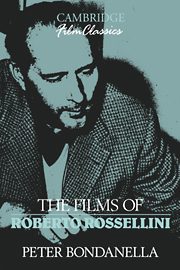Book contents
- Frontmatter
- Contents
- List of Illustrations
- Preface
- 1 Rossellini and Realism: The Trajectory of a Career
- 2 L'uomo dalla croce: Rossellini and Fascist Cinema
- 3 Roma città aperta and the Birth of Italian Neorealism
- 4 Paisà and the Rejection of Traditional Narrative Cinema
- 5 La macchina ammazzacattivi: Doubts about the Movie Camera as a Morally Redemptive Force
- 6 Viaggio in Italia: Ingrid Bergman and a New Cinema of Psychological Introspection
- 7 Il generale Della Rovere: Commercial Success and a Reconsideration of Neorealism
- 8 La prise de pouvoir par Louis XIV: Toward a Didactic Cinema for Television
- Notes
- Chronology
- Filmography
- Bibliography
- Index
1 - Rossellini and Realism: The Trajectory of a Career
Published online by Cambridge University Press: 12 January 2010
- Frontmatter
- Contents
- List of Illustrations
- Preface
- 1 Rossellini and Realism: The Trajectory of a Career
- 2 L'uomo dalla croce: Rossellini and Fascist Cinema
- 3 Roma città aperta and the Birth of Italian Neorealism
- 4 Paisà and the Rejection of Traditional Narrative Cinema
- 5 La macchina ammazzacattivi: Doubts about the Movie Camera as a Morally Redemptive Force
- 6 Viaggio in Italia: Ingrid Bergman and a New Cinema of Psychological Introspection
- 7 Il generale Della Rovere: Commercial Success and a Reconsideration of Neorealism
- 8 La prise de pouvoir par Louis XIV: Toward a Didactic Cinema for Television
- Notes
- Chronology
- Filmography
- Bibliography
- Index
Summary
When Roberto Rossellini was born on 8 May 1906 into a very well-to-do Roman family, his father's involvement in the design and construction of the Cinema Corso, still one of the most important theaters of Italy's capital, was an auspicious coincidence that, in retrospect, seems to foretell his eventual choice of profession. But little about Rossellini's early years will help explain why his name would eventually be inextricably connected to the moment in Italian cinematic history known as neorealism, or why his entire career would be continuously defined by controversial discussions over the relationship between art and realism, cinema and society. At the fashionable Collegio Nazareno where Rossellini attended high school, he made a number of friends who would later prove useful to his career: Marcello Pagliero, later to play the role of the Communist partisan leader in Roma città aperta; Giorgio Amendola, who was the son of one of Italy's most famous antifascist leaders and became an important member of the Italian Communist Party and delivered Rossellini's funeral oration on 6 June 1977; and Franco Riganti, who became a film producer in the fascist period and provided Rossellini with an entrée into the film industry.
As a result of his excellent social and economic position, his charming personality, and his good looks, Rossellini seemed destined to become a playboy rather than a film director, and there was always something of the nonchalance of the nonspecialist in his approach to the cinema.
- Type
- Chapter
- Information
- The Films of Roberto Rossellini , pp. 1 - 31Publisher: Cambridge University PressPrint publication year: 1993



